Instead of being Brazil’s rough and tough bad boy, Rio de Janeiro could be the most beautiful city on the planet. There are the ocean, the beaches, the hills, the vegetation, the views….I could go on and on.
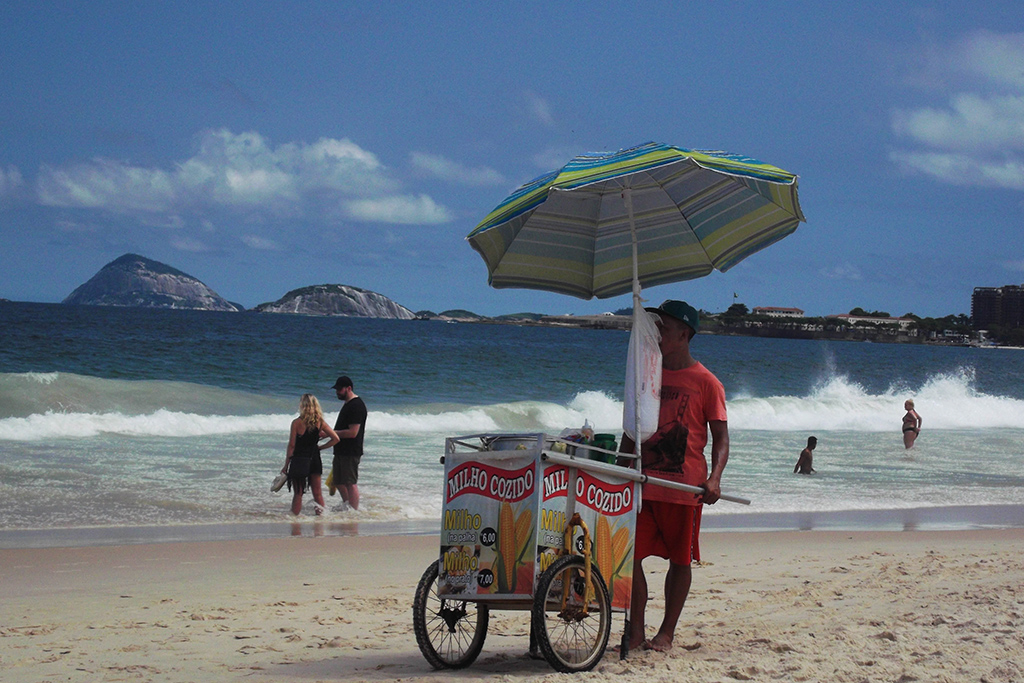
But then there is the poverty, the violence, the hopelessness, the corruption, the dirt….I could go on and on.
And I do. In this refined guide to a rough city.
When visiting Brazil, a trip to Rio is inevitable. The country’s most important icons are not in São Paulo. They are neither in Recife nor in Salvador.
Whether it’s Christ the Redeemer, whether it’s the sugar loaf, or the world’s most famous beaches Copacabana and Ipanema – all these sights and signs are right here.
So – bem vindos no Rio!
Bem Vindos no Rio!
Rio de Janeiro is the second-largest city in Brazil after São Paulo and the capital of the state of the same name. It is located on Guanabara Bay in Brazil’s southeastern part.
From 1815 to 1821, Rio de Janeiro was actually the capital of the Kingdom of Portugal and Brazil. After Brazil’s independence, it remained the country’s capital until 1960. After that, she ceded this function to Brasília. However, with around 6.5 million inhabitants, Rio remains the country’s most important commercial and financial center after São Paulo.

A chain of hills divides the urban area into two parts. The Zona Sul, the Southern Zone, stretches along the Atlantic coast. Hence, here are also the famous beach districts of Ipanema and Copacabana. The northern part, on the other hand, includes the historic city center and today’s business center.
The guide to Rio that you are about to read is structured according to this geographical layout.
Different Conditions in the Hoods
The above-mentioned granite hills also include the two landmarks of Rio, the 394 meters high Sugar Loaf, located directly on a peninsula in Guanabara Bay, and the 704 meters high Corcovado with the Christ statue on the summit. Another one is the 533 meters high Morro Dois Irmãos. The highest point of the urban area is the 1022-meter-high Pico da Tijuca, which is located in the middle of an extensive nature reserve.
Although it is quite normal that a big city consists of different neighborhoods, the immense socio-economic differences in Rio de Janeiro are just mindblowing – and sometimes also heartbreaking.

Most tourists and travellers stay in the Copacabana area which is understandable since you have the iconic beach literally at your feet. On the other hand, it is the best place to learn basically nothing at all about many other aspects of Brazil.
However, right behind the Copacabana is the Leme neighborhood which gives you a far better idea of what Brazil is really like.
Botafogo and Flamengo
I stayed in the Botafogo district. To me, it’s the ideal place, hence, I can only recommend it.
Botafogo is a mostly residential, middle-class neighborhood. Rather quiet, yet very pleasant. Also, it’s only one subway stop to the famous beaches. It is really close to the – partly a bit too run down – business center with all the museums and shopping opportunities.

Talking ’bout shopping: There is a big mall right next to the beach in Botafogo.

A beach? Yes, that’s right, there is also a beach, but unfortunately, you can only go for a walk there and enjoy the incredible view of the Sugar Loaf since it’s far too dirty to bathe or sunbathe there.

A huge plus is Botafogo’s location: There is an incredible number of buses passing in front of the shopping mall, the ‘Metrô na Superficie’ – which is just a faster bus and no Metrô at all – and two subway lines. It cannot get more convenient!
Very similar is the Neighborhood of Flamengo, only it’s not as centrally located as Botafogo, but only one subway stop away.
I would always prefer the last two neighborhoods for their closeness to Brazilian life.
Santa Teresa
I also love the neighborhood of Santa Teresa which is on one of the many ‘morros’, the hills typical for Rio de Janeiro. Unfortunately, it’s located amidst a couple of Favelas, one of them being the notorious Morro dos Prazeres – Hill of Pleasures. This Favela was considered pacified until recently two tourists were shot there; accidentally, wrong moment – wrong place, but does that really matter?!

My Portuguese teacher was a bit shocked when I told her that I was walking down the Rua Santa Cristina by myself.
According to prudent Cariocas, as the people of Rio are called, even the once pacified Favelas are dangerous again. I personally would not go there – especially since I find it a bit weird to go to a neighborhood to see how poor people live. Just ask yourself if you are doing this in your city, too – and then ask yourself why you should do it in Rio.
However, Santa Teresa is beautiful and they have hostels there. I don’t know how people who stay there manage.
West
Jardim Botânico do Rio de Janeiro
Let’s just work our way around Rio starting in the west. The south-west, to be precise. And precise is key here since the northern parts of the city are the rough regions while the farther south you get, the more sophisticated get the neighborhoods.
About four blocks north of the beach of Ipanema is the Lagoa Rodrigo de Freitas. Wealthy Cariocas enjoy walking and jogging around this beautiful lagoon or hanging out at the posh Clube dos Caiꞔaras.
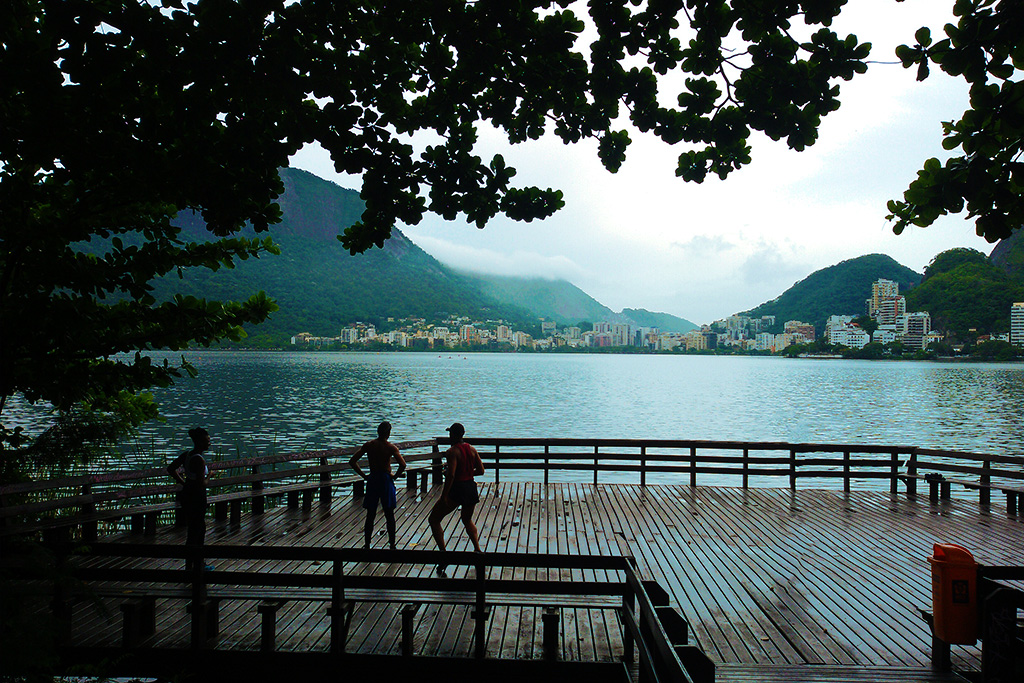
As you walk westwards around the lagoon, enjoying great views of Rio, you’ll first get to the Hipódromo da Gávea, the Jockey Club. It’s worth taking a closer look at the club’s fence since it’s decorated with a fun mural of viewers of a horse race.
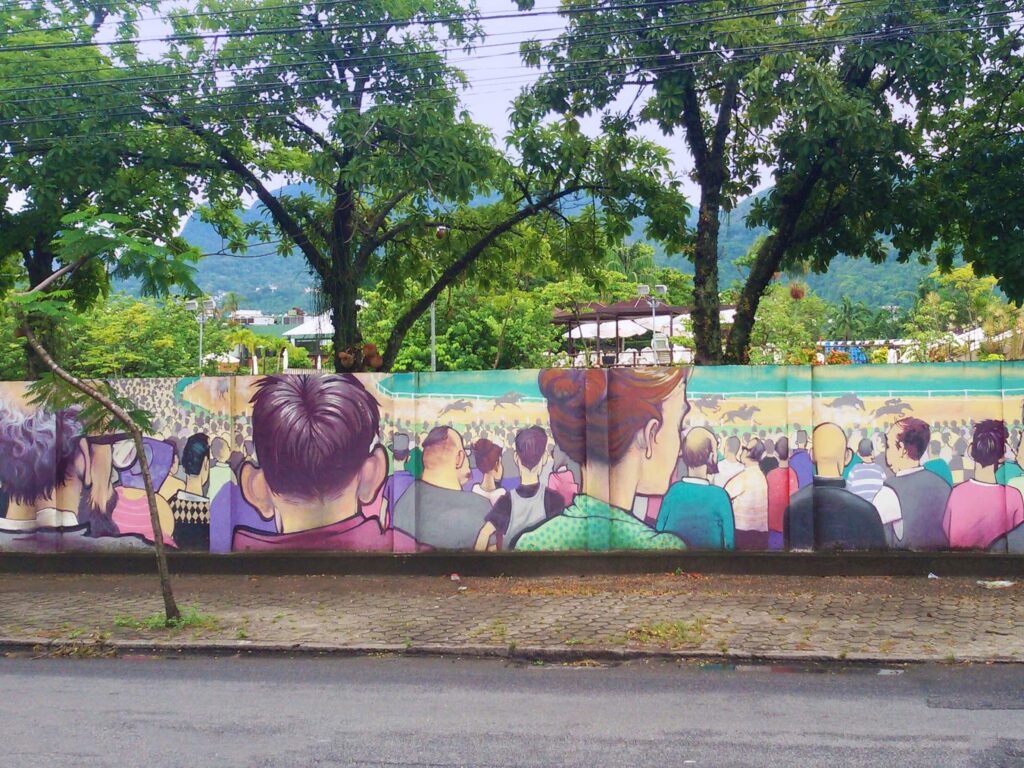
At the end of the club, turn left into the Rua General Garzon and you arrive at the north entrance of the Jardim Botânico, Rio’s botanic garden, mostly known for its glorious palm-fringed avenue. But there are definitely many attractions – 9,000 plants from about 1,500 different species beautifully arranged between walkways, on hills, around ponds, and fountains.

If you want to spend a couple of hours in a tranquil environment, soothing for the eye and the soul alike, this is the place to go.
Of course, you do not have to walk around the lagoon to get to the garden. There are many buses going there – just type your starting point in this map and you’re ready to go.
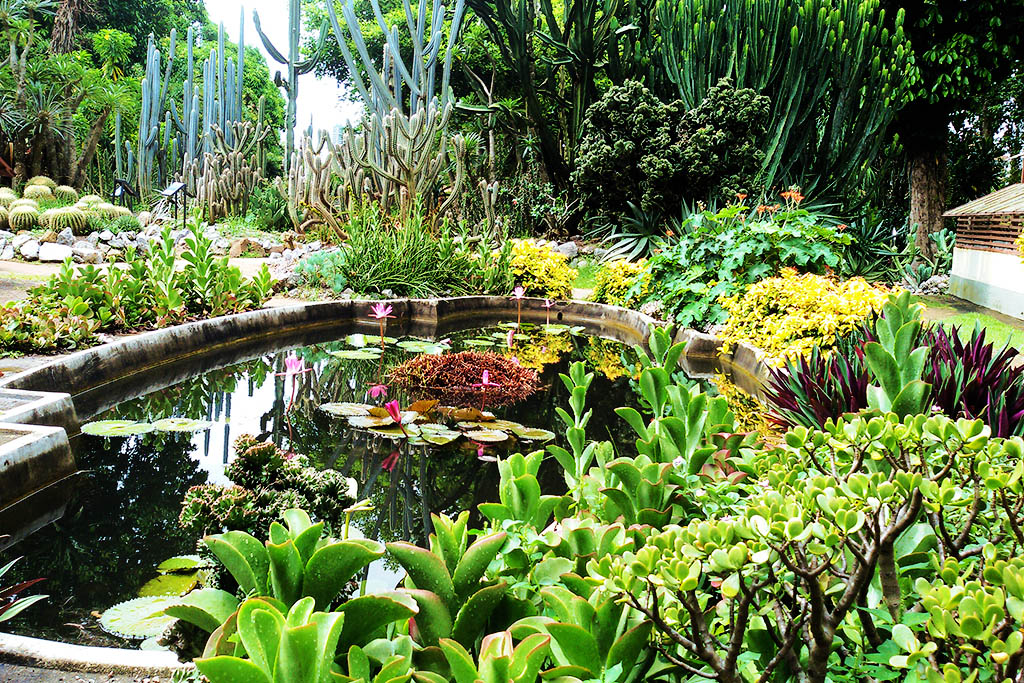
Jardim Botânico do Rio de Janeiro
Rua Jardim Botânico 1008
Rio de Janeiro
Phone: + 55 – 21 – 38 74 18 08 and 38 74 12 14
Email: jbrj@jbrj.gov.br
Open Tuesday to Sunday from 8 a. m. to 5 p. m. and Monday from noon to 5 p. m.
The entrance fee is R$ 15 and they don’t accept credit cards – which is very unusual in Brazil.
South
Well, besides the Cristo and the Sugar Loaf, the southern part of the city is what Rio stands for: The beaches!
Ipanema
They are city beaches, yes. However, they are very nice and relatively clean.
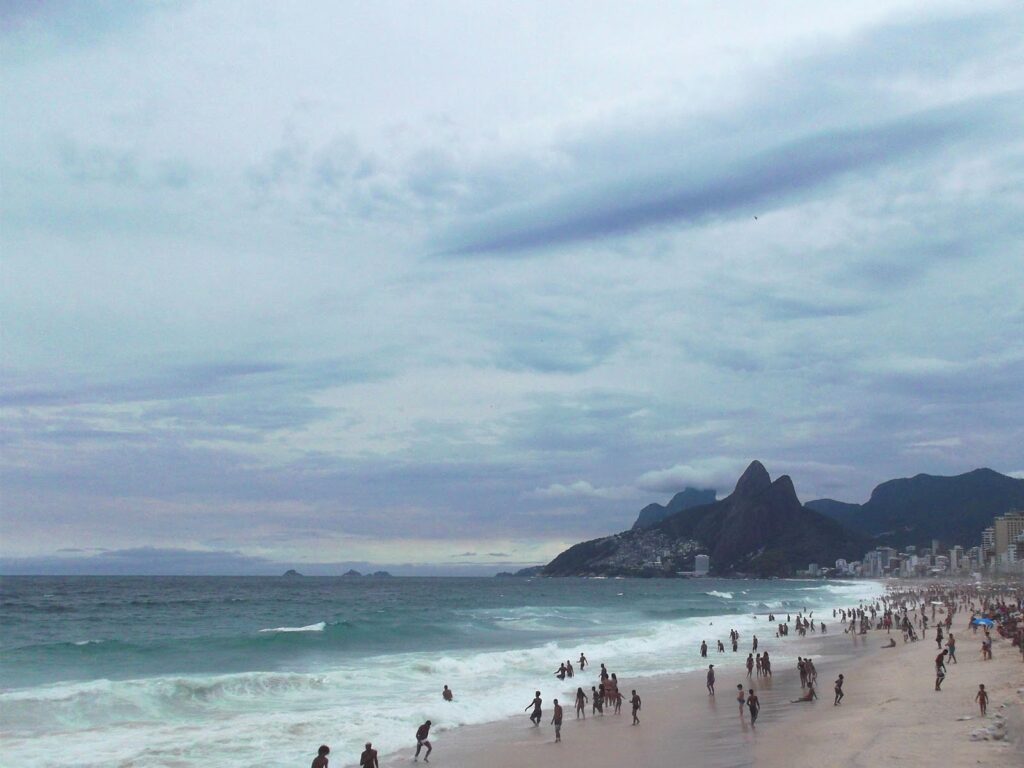
It starts in the west with Praia do Leblon, leading into the Praia de Ipanema and Praia do Arpoador.
In this spot, you cannot continue, but have to cross the Parque Garota de Ipanema.
Copacabana
From this park called after the girl of Ipanema, you need to walk down the Rua F Otaviano before you can get back to the beach. Yes, the world’s famous Praia de Copacabana.

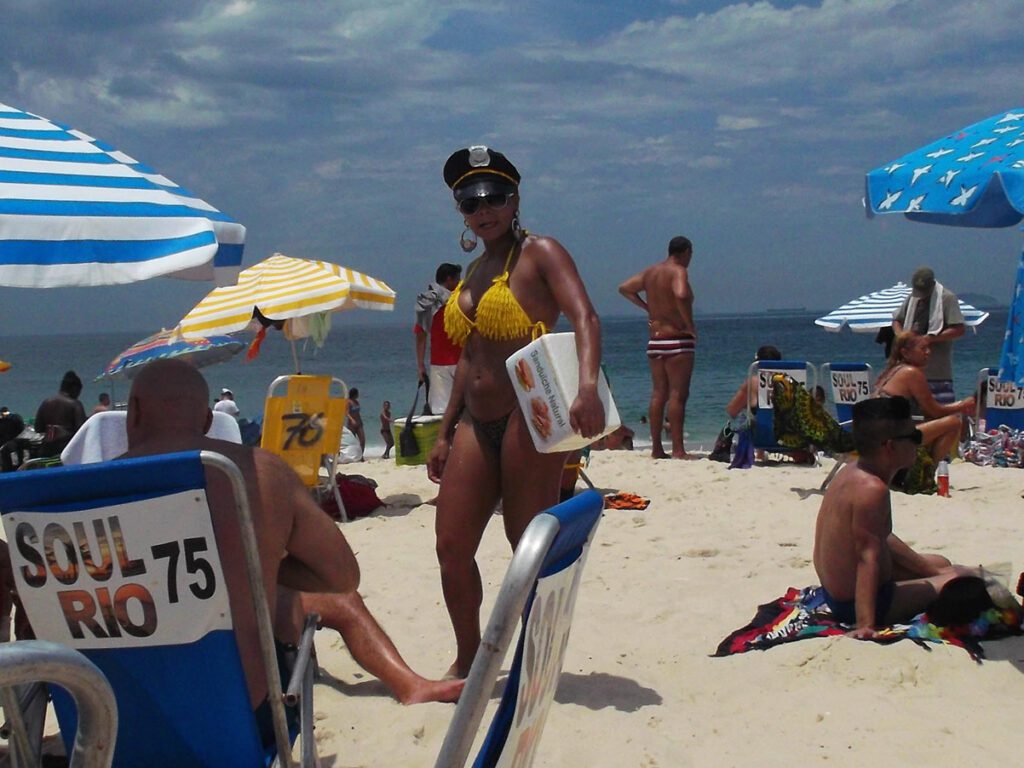
The Copacabana is hemmed with bars and restaurants, there is a market where you can buy souvenirs, there are public bathrooms – they really make sure that tourists have a good time.
Southeast
Pão de Açûcar
Behind the Morro do Leme is Urca, another very nice part of Rio, crowned by the Pão de Açûcar, the sugar loaf.
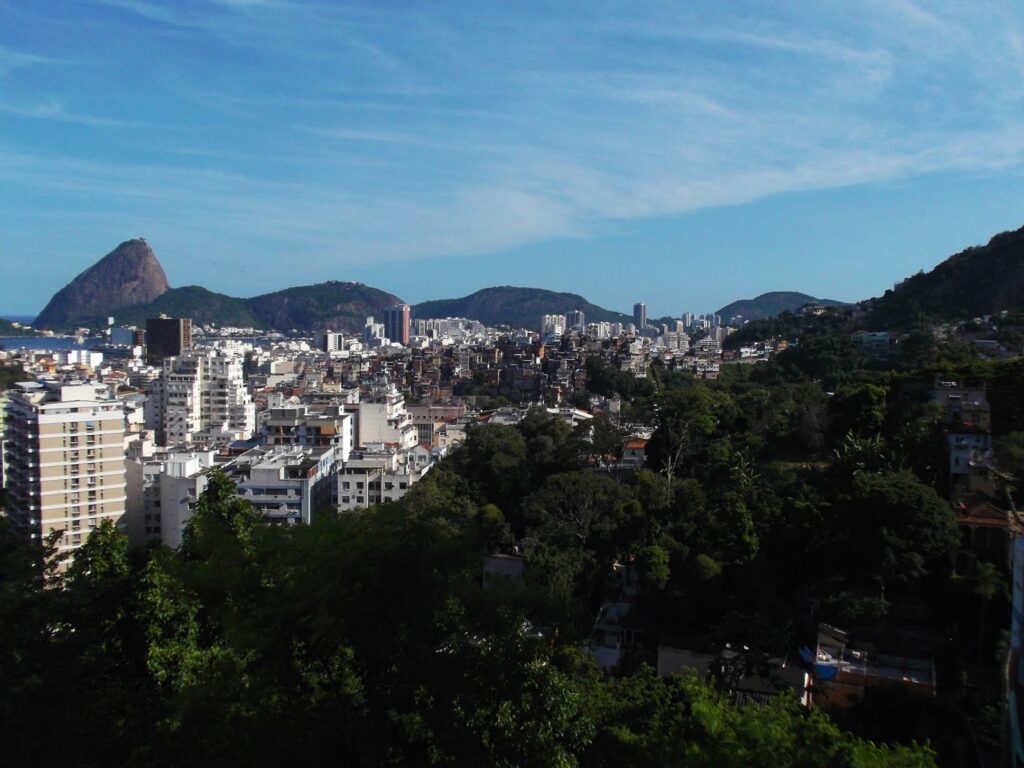
Going up is divided into two parts – first, you get to the Morro do Urca and eventually to the Pão. From here you have the most glorious view.
Bonde Pão de Açûcar
Avenida Pasteur 520
Rio de Janeiro
Phone: + 55 – 21 – 25 46 84 33
Email: sac@bondinho.com.br
For R$ 80, you can go up every day between 8 a. m. and 7.50 p. m.
Once you are in the Urca and Praia Vermelha neighborhood, make sure to stroll around a bit – from here you can even walk along Avenida Pasteur to Botafogo – passing the Yacht club and the soccer clubhouse of the rather hapless team of Botafogo.
Cristo Redentor and Trem do Corcovado
To get to the next – and most important – attraction of Rio de Janeiro, you have to leave the coastline and take the subway at Botafogo station northbound to Largo do Machado – which is two stops. There you catch bus #583 that takes you straight to the Trem do Corcovado – the train taking you up to Jesus.
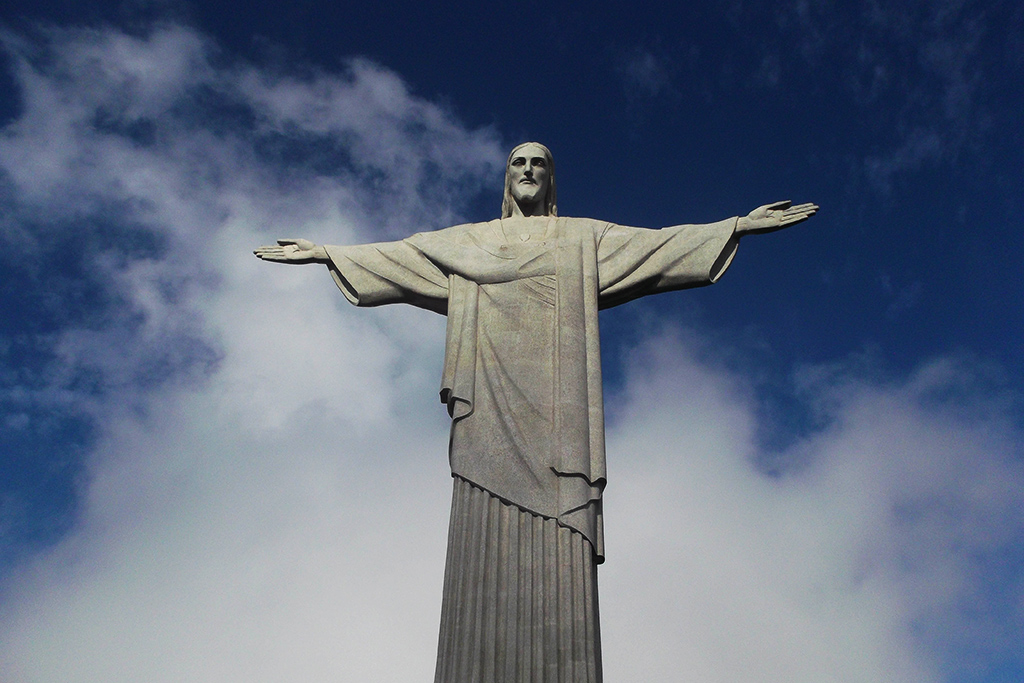
This Christ statue was created in the art deco style by French sculptor Paul Landowski. The sculpture – 30 meters tall – was constructed between 1922 and 1931. Christ is protecting the city of Rio with his arms opened over a stretch of 28 meters.
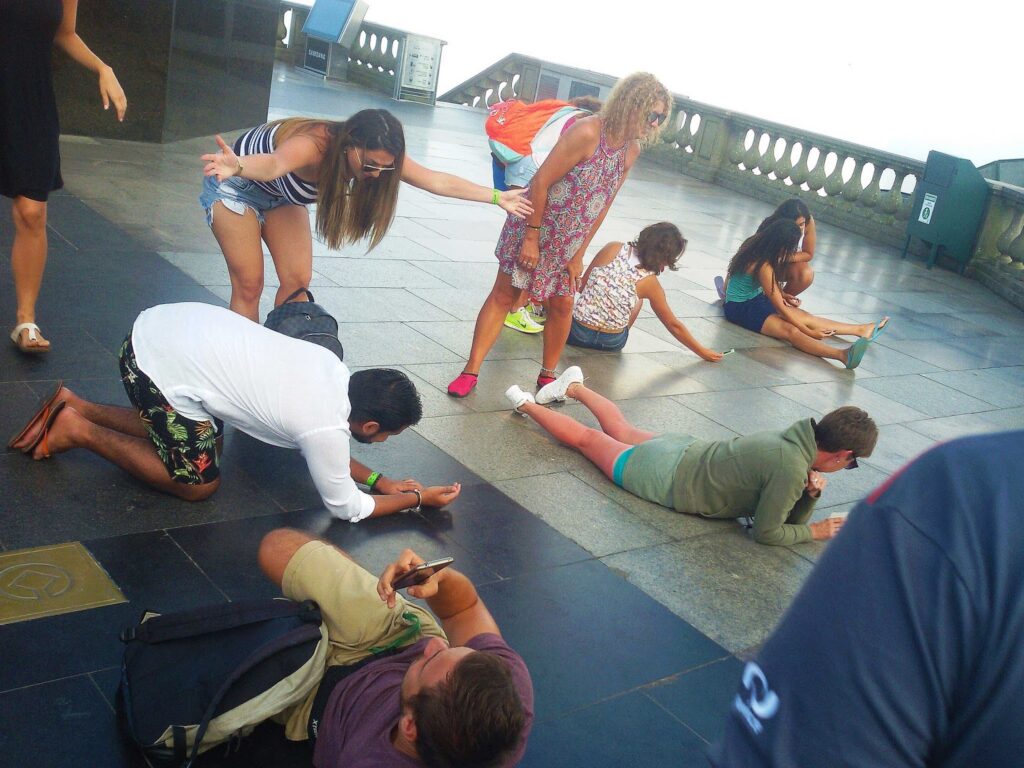
Note: You cannot buy a ticket for the same day at the trem station. You need to buy the ticket either online or from an authorized dealer. At the trem station’s booth, you can only change your voucher for your ticket. Especially during high season, I recommend getting your ticket well ahead.
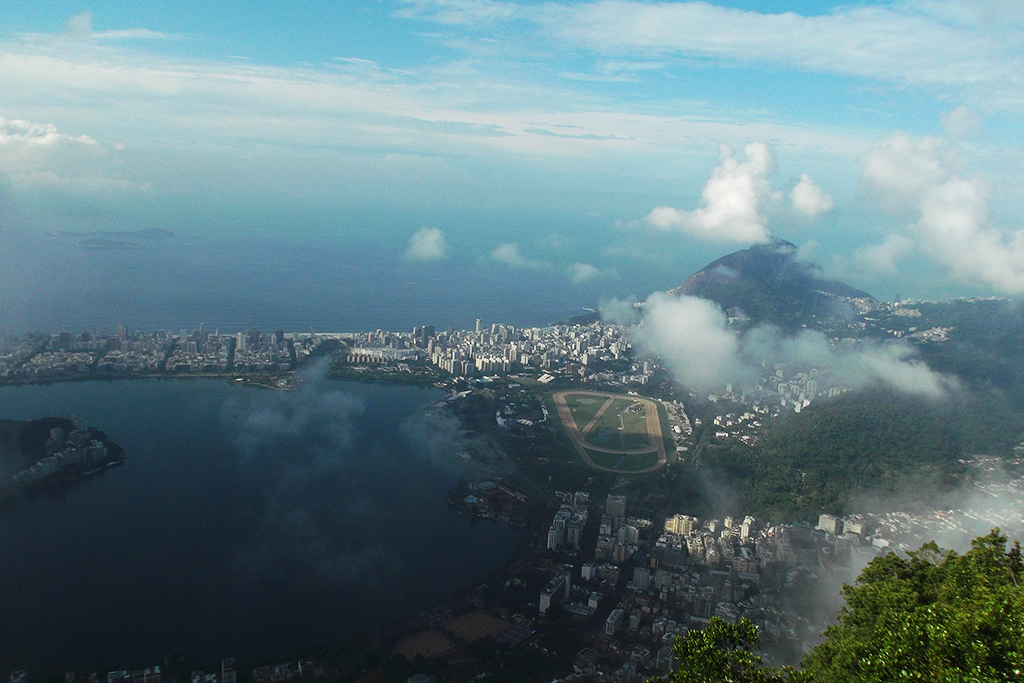
Trem do Corcovado
Rua Cosme Velho 513
Rio de Janeiro
Phone: + 55 – 21 – 25 58 13 29
The Cristo Redentor can be visited from Tuesday to Sunday from 8 a. m. to 7 p. m.
The train is leaving every 30 minutes and online tickets are R$ 89.50 during high season and R$ 72.50 during low season.
East
Museu de Arte Moderna (MAM)
Continue the coastline up north passing Praia do Flamengo and you’ll get the Parque do Flamengo where the quite interesting Museu de Arte Moderna (MAM) is located.

This venue is located in a park designed by one of the most influential landscape architect Roberto Burle Marx. I’m introducing another of his fantastic creations in my post on Inhotim, a mesmerizing botanic garden and art venue on the outskirts of Brumadinho. Roberto Burle Marx is actually distantly related to German philosopher and politician Karl Marx.


I love the idea that people working day by day at this place become part of the exhibition.
Original and respectful from the Italian artist Lucio Salvatore.
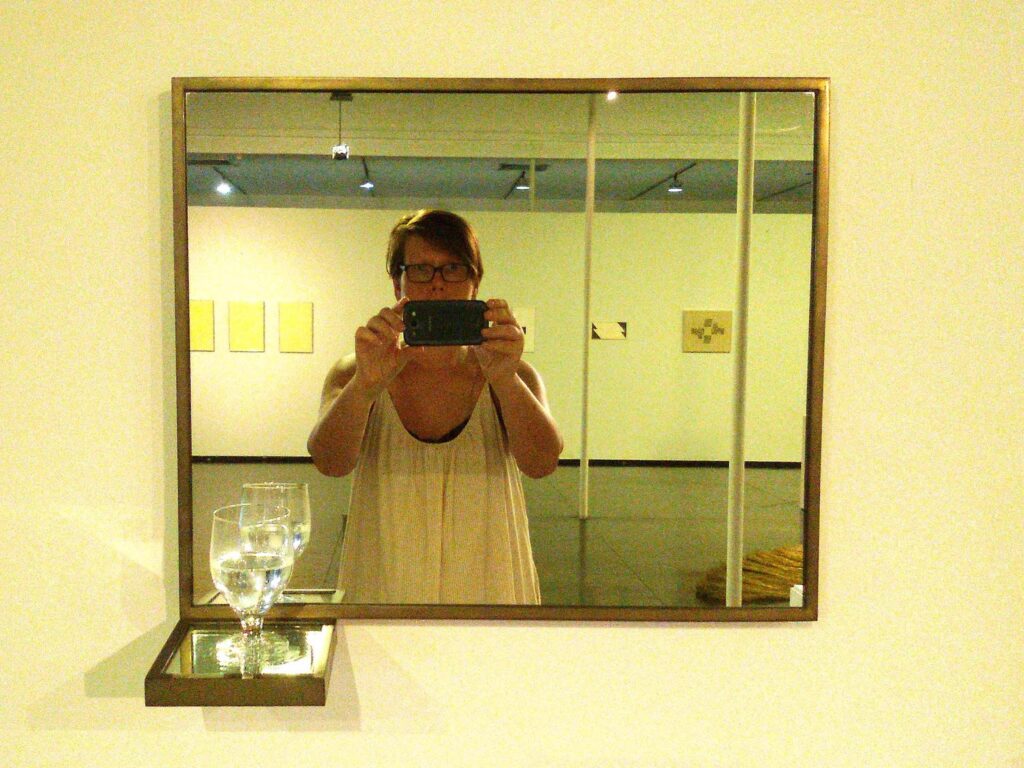
Although the museums own a collection of 12,000 pieces, their temporary exhibitions are far more interesting.

Museu de Arte Moderna (MAM)
Avenida Infante Dom Henrique 85
Rio de Janeiro
Phone: + 55 – 21 – 38 83 56 00
Email: atendimento@mamrio.org.br
Escadaria do Selarón
Walk down the Avenida Infante Dom Henrique and turn right into Rua Teixeira de Freitas and follow Rua Teotônio Regadas – here you are, at one of the most intriguing pieces of Rio’s street art, the Escadaria do Selarón.
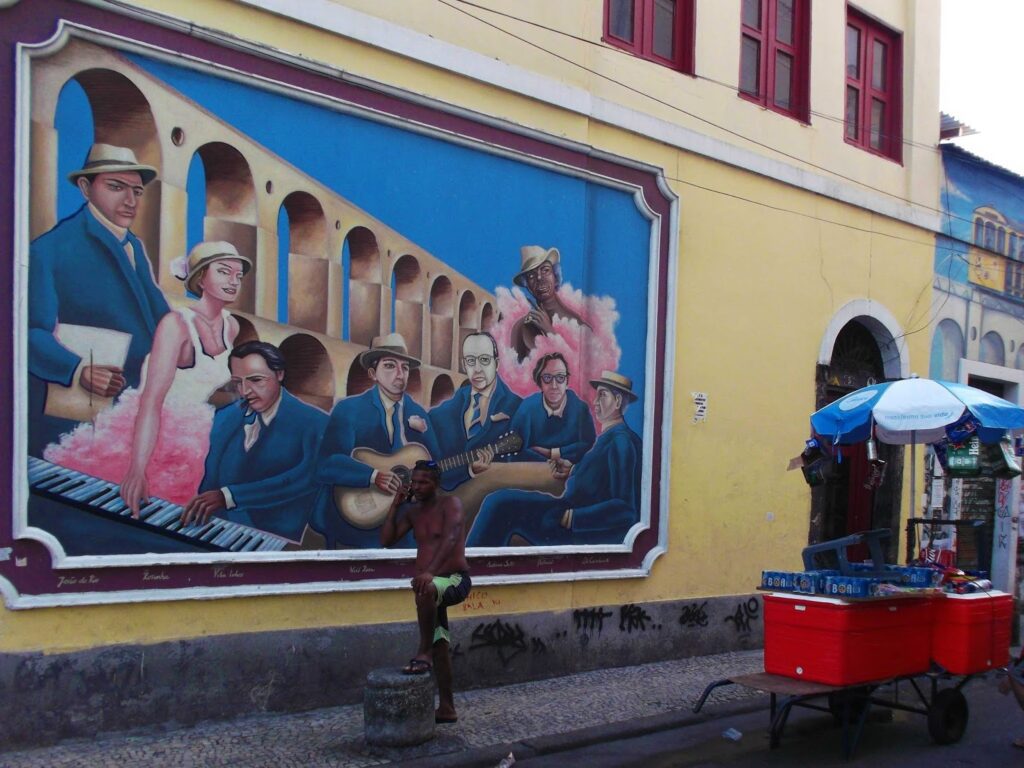
These stairs leading to the neighborhood of Santa Teresa consist of 215 beautifully decorated steps.
Chile-born Jorge Selarón decorated them with tiles from over 60 countries: First, the artist used tiles from construction sites and waste dumps, but eventually, visitors from around the world contributed.

Of the over 2000 tiles, about 300 are handpainted by the artist depicting a pregnant African woman. Selarón claimed he financed his work by selling more than 25,000 portraits of this lady.
Jorge Selaron settled in Rio de Janeiro in 1983 and began to ‘renovate’ the stairs in 1990. Until his mysterious death in 2013, he never considered his work done. As soon as he finished one section, he started to work on another one.
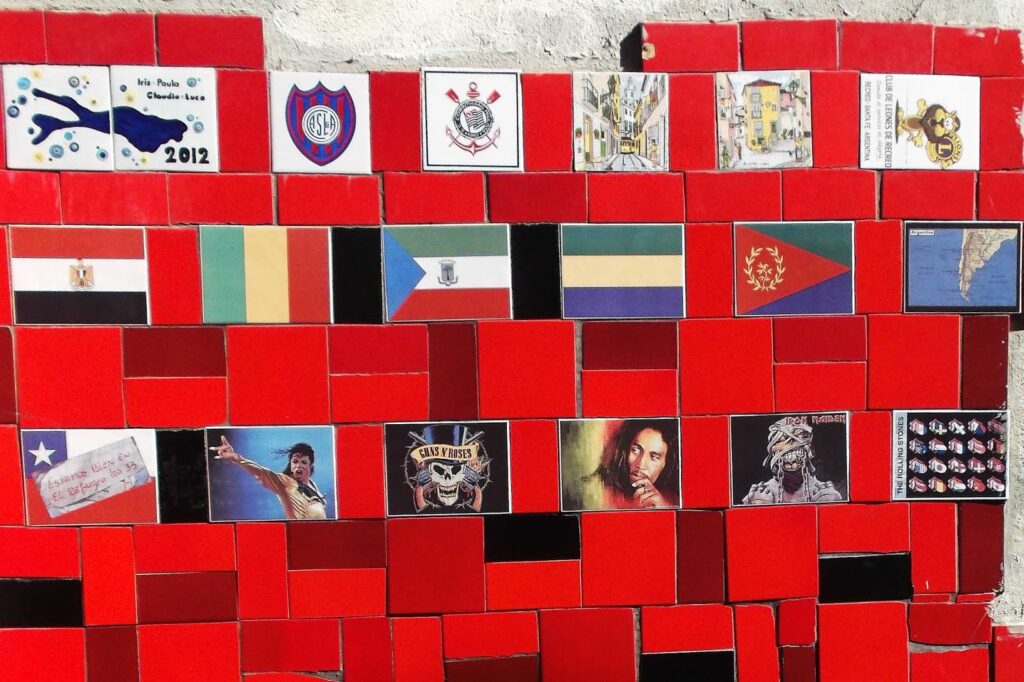
Selarón was found dead on his famous steps on January 10, 2013. Until this day the circumstances of his death are unclear.

I’ve dedicated an entire post to Rio’s fantastic Street Art.
Parque das Ruinas
Once you climb up the stairs – which might take a while not because of the height, but because there are millions of details to be admired – you can continue your walk to the Parque das Ruinas from where you have the best view of all that makes Rio grand.
Little tip: If you don’t have much time in Rio and can make it to only one observation platform, you might consider coming to this park instead of standing in line at the Trem do Corcovado or the Bonde Pão de Açûcar.
From the Parque das Ruinas, it’s only a short walk – alongside cute little specialty shops, you might consider doing your souvenir shopping right here – to the Largo do Guimarães. From here you can take the old Bonde, the tram, back down to Lapa.
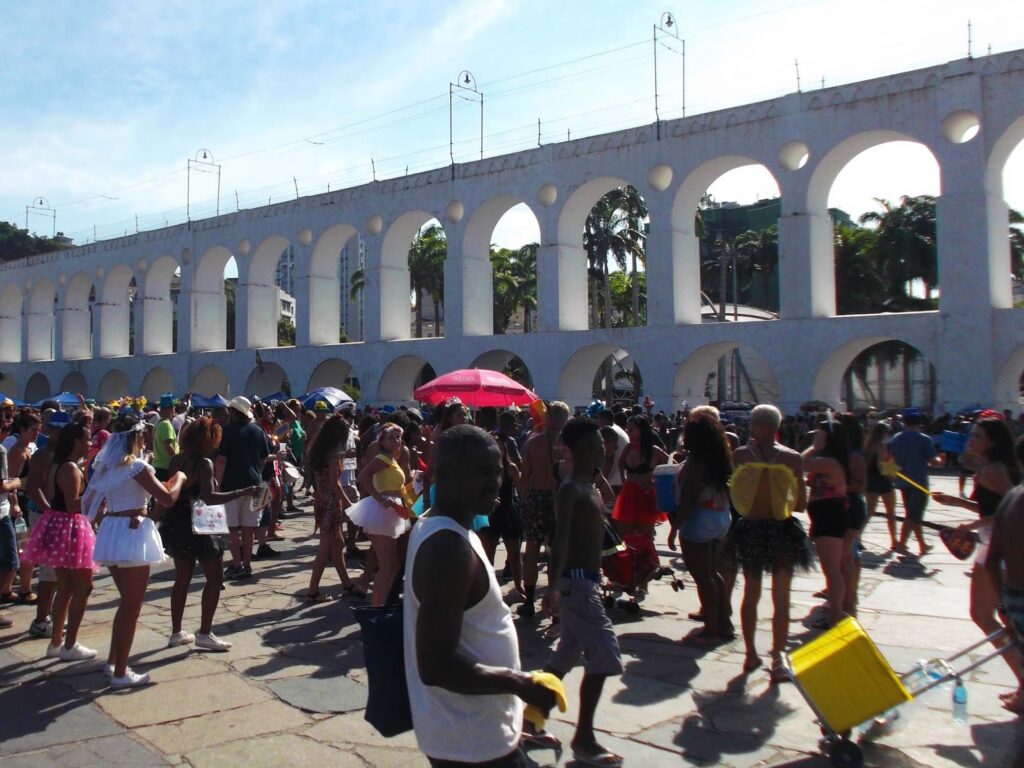
It is better to do it this way for two reasons: Climbing the Selarón stairs up gives you a much better view of all the details than taking them down; and while they charge you R$ 20 for the tram when coming up, taking it downhill from Santa Teresa is actually free.
Northeast
Lapa
Coming back from Santa Teresa to Lapa, you’ll find yourself in the city’s old, historic neighborhoods – and busiest business and shopping streets.
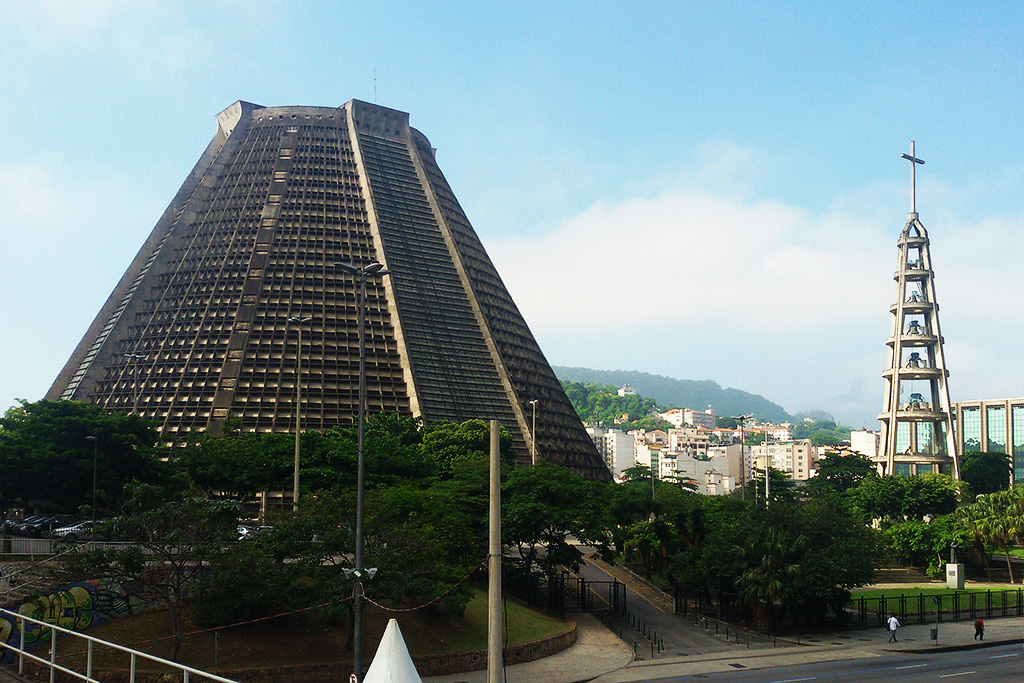
This nuclear power plant-like house of God is also very close to the Largo da Lapa.
Walk down the Rua Evaristo da Veiga to the Praça Floriano dominated on its northern end by the Teatro Municipal, built from 1904 to 1909 in an Eclectic and Art Nouveau style – inspired by the opera house in Paris.
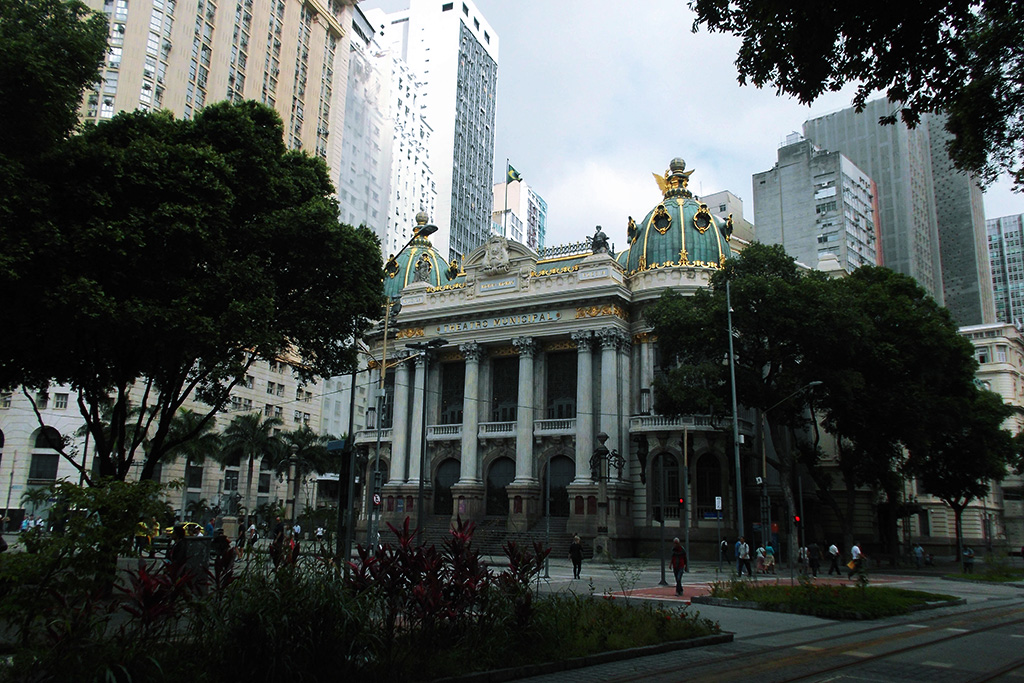
Next to it, you’ll find the Museu Nacional de Belas Artes, housing fine international and Brazilian art such as sculpture, painting, drawings, and photography.
Museu Nacional de Belas Artes
Avenida Rio Branco, 199 – Centro (Cinelândia) Rio de Janeiro RJ – CEP: 20040-008 – Telefone: (21) 3299-0600
Terça a sexta-feira das 10 às 18hs; Sábados, domingos e feriados das 13 às 18 horas. Ingressos: R$ 8,00 Sunday free
Around Praça Tiradentes
As you continue on the Avenida Rio Branco, don’t miss the lovely colonial church Igreja Nossa Senhora do Parto to your left right before Rua da Carioca.
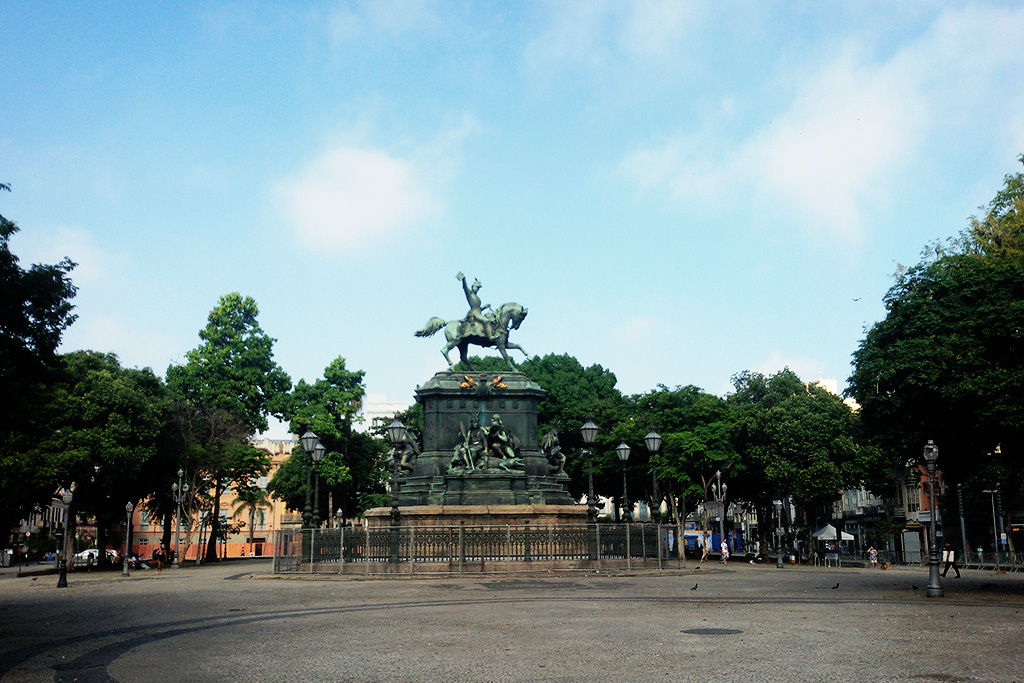
Rua da Carioca ends at the Praça Tiradentes. It’s actually a rather unspectacular square.

However, turning right, you’ll see the Real Gabinete Português de Leitura, a beautiful library founded in 1837 by immigrants from Portugal. This way, they intended to maintain the Portuguese language.
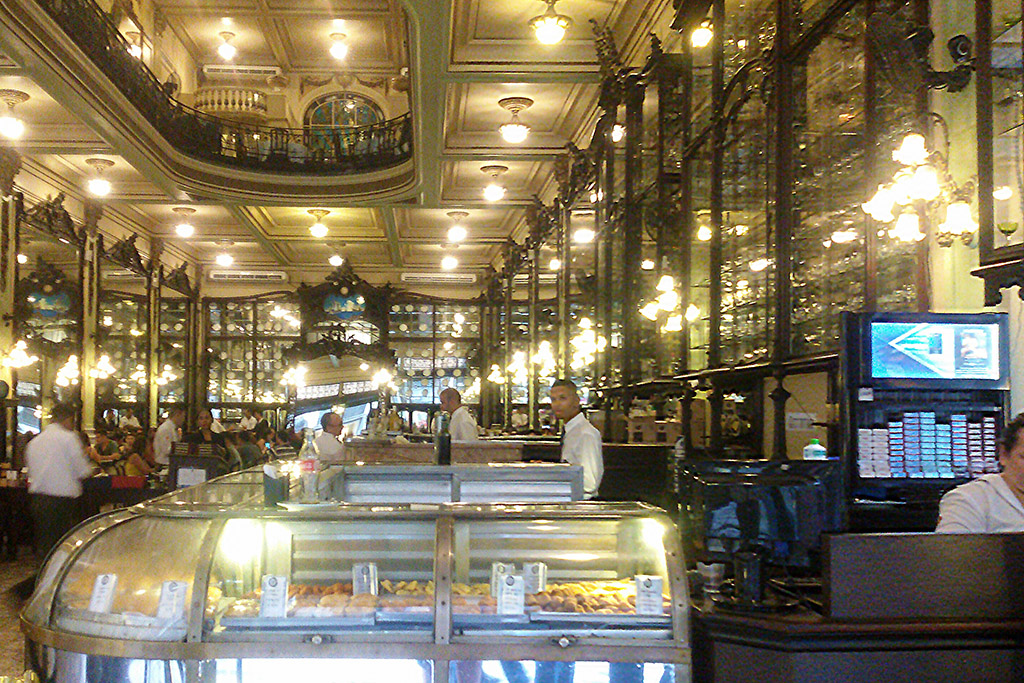
Check for yourself between 9 a. m. and 7 p. m. at Rua Gonçalves Dias 32.
Walking from Praça Tiradentes towards the Guanabara Bay, you’ll get to the majestic Assembleia Legislativa do Estado do Rio de Janeiro, the Seat of the State Assembly.

Turn left and walk up north, passing three ladies. What – three ladies? Yes, first to your left is Nossa Senhora – which means ‘our lady’ – do Carino.
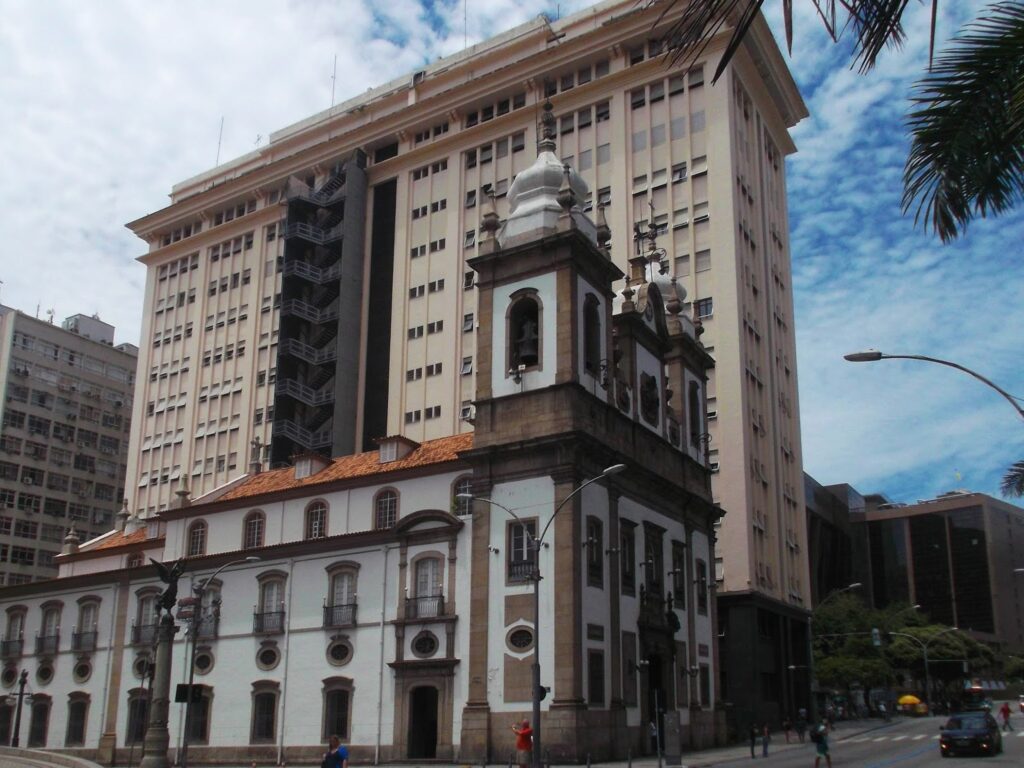
One blog further to your right Nossa Senhora da Lapa dos Mercadores and finally at the Praça Pio X the baroque Nossa Senhora da Candelária.
North
When I write north, I’m talking about the northern part of the center. I would never dare to send you to the north of Rio and I cannot recommend to venture there by yourself.

In front of it the Praca Mauá, behind it the bridge connecting Rio and Niterói.
So the most northern area for us is the Praça Mauá where you’ll find the spectacular Museu do Amanha – the museum of tomorrow. This institution is dealing with all different aspects of planet earth and its inhabitants.
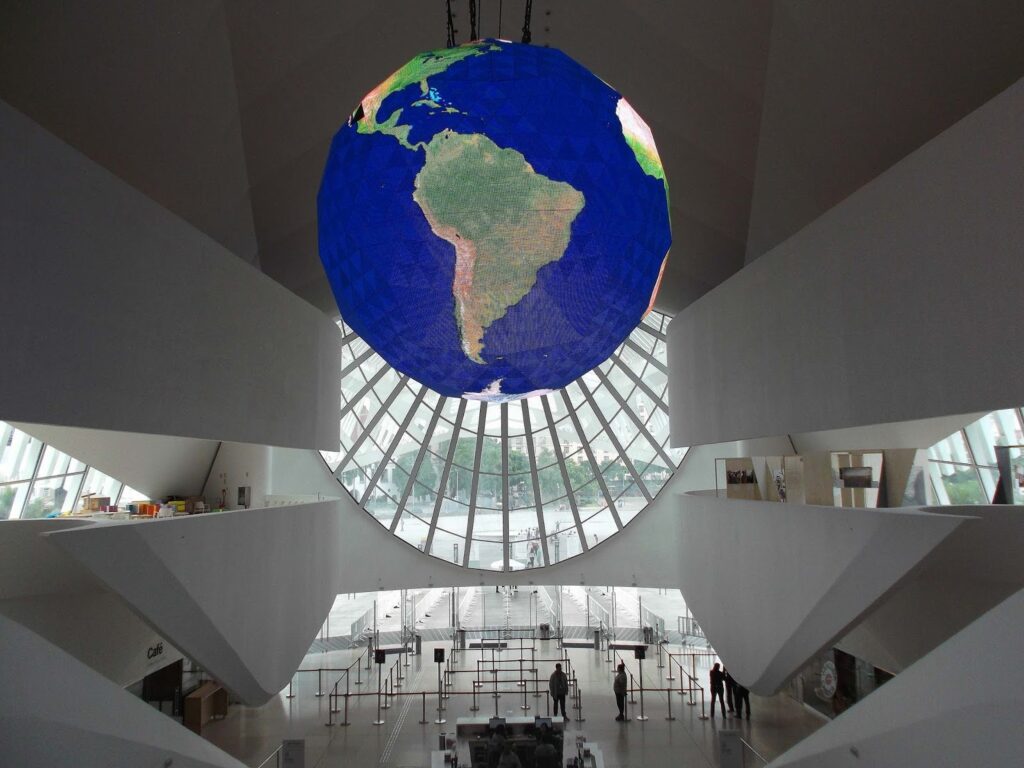
Interesting facts and fun hands-on exhibitions – but also the unusual appearance of the building, designed by Santiago Calatrava and opened in 2015, make this museum a must-see when in Rio.
To see more of Calatrava’s amazing creations, check out my post on Valencia where he designed many of the buildings at the City of Arts and Science.
Museu do Amanha
Praça Mauá 1
Rio de Janeiro
Open Tuesday to Sunday from 10 a. m. to 6 p. m., the entrance fee is R$ 20

Across the Mauá Square is another museum, the Museu de Arte do Rio (MAR), housing different exhibitions on Rio-related topics.
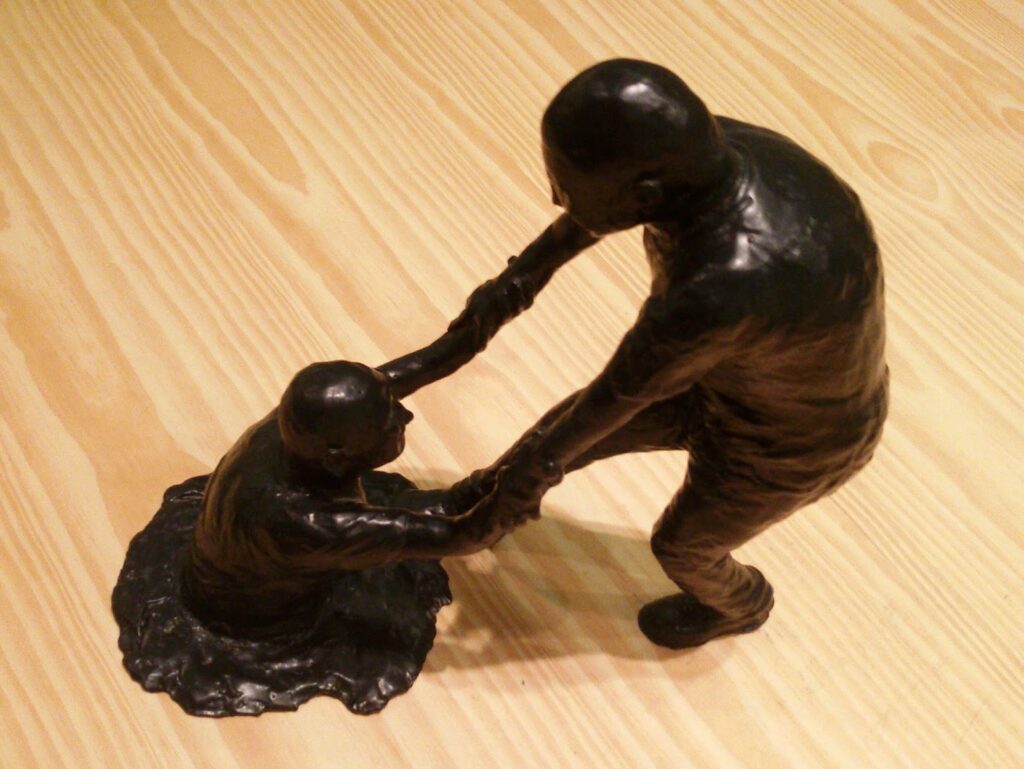
Gustavo Rezende Qual é a matéria do sonho? which translates to What’s the material of the dream?
To be honest, the most impressive thing about this venue which was opened in 2013, is the building itself. It was designed by Paulo Jacobsen, Bernardo Jacobsen, and Thiago Bernardes and grants a fantastic view of the adjacent Museu do Amanha and the Baía de Guanabara, the Guanabara Bay.
Museu de Arte do Rio
Praça Mauá 5
Rio de Janeiro
Ethnicity
Much better art can be seen alongside the adjacent Avenida Rodrigues Alves.
The main work was painted by Brazil’s graffiti superstar Eduardo Kobra. He created his epic mural Ethnicity on the occasion of the Olympic Games in 2016.

However, also other very talented muralists perpetuated themselves on these walls and abandoned buildings.
I’ve dedicated an entire post to Rio’s fantastic Street Art.
The Avenida Rodrigues Alves is also the perfect place to grab a bite – or a souvenir – and watch people strolling by between old structures of the former storehouses – the global gentrification you find in basically every bigger city.
Maracanã
The last northern stop was not for me, but it will be for you, you soccer aficionados: If you walk back to the Praça Pio X and take the subway at the Uruguaiana station, it will take you right to the soccer mecca, Estádio Mário Filho, better known as Maracanã.
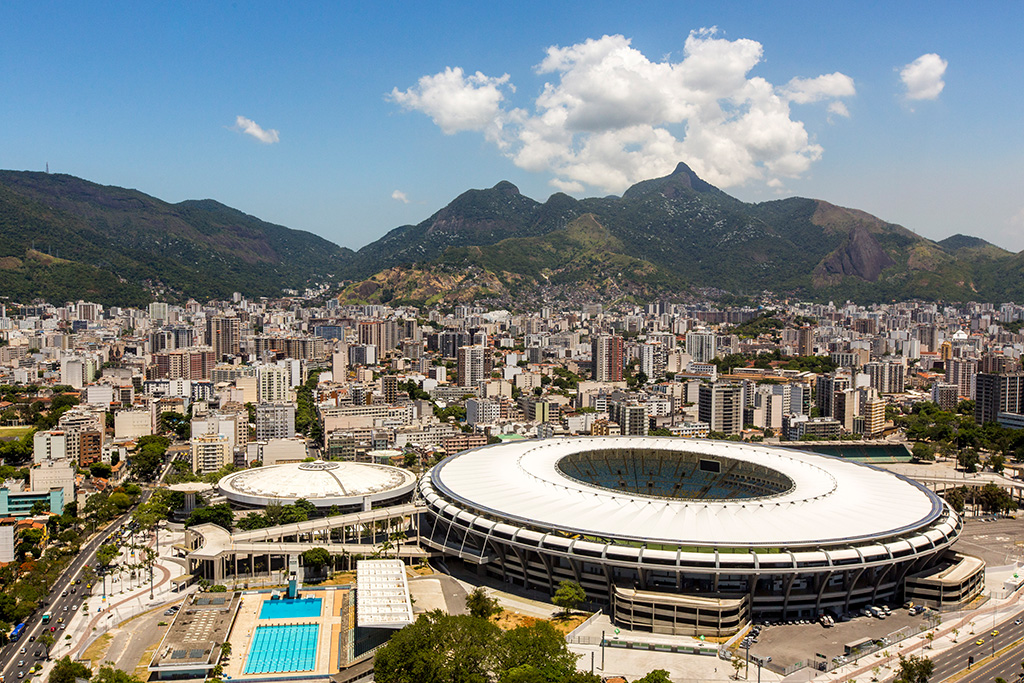
(Photo: Daniel Basil, Maracanã 2014 g, CC BY 3.0 BR)
The stadium can be visited, The tours last an average of 40 minutes, but on days when a match is taking place, the last tour finishes three hours before the game.

Estádio Mário Filho
Avenida Presidente Castelo Branco
Gate 2
Rio de Janeiro
Can be visited daily from 9 a. m. to 4 p. m.
A guided tour costs R$ 60, a non-guided tour costs R$ 50
Niteroi
The last place I’d like to introduce is located on the other side of the Baía de Guanabara. It’s the town of Niterói.
Ferry Ride
Niteroi is worth the visit for three main reasons. Firstly, you cross the Baía de Guanabara on a comfortable, relatively cheap ferry. Secondly, from the other side of the bay, you have a great view of Rio de Janeiro. And last but not least, you get to visit one of the most important buildings that the world-famous Brazilian Oscar Niemeyer designed. It’s shaped like a flying saucer and houses the Museu de Arte Contemporânea de Niterói.
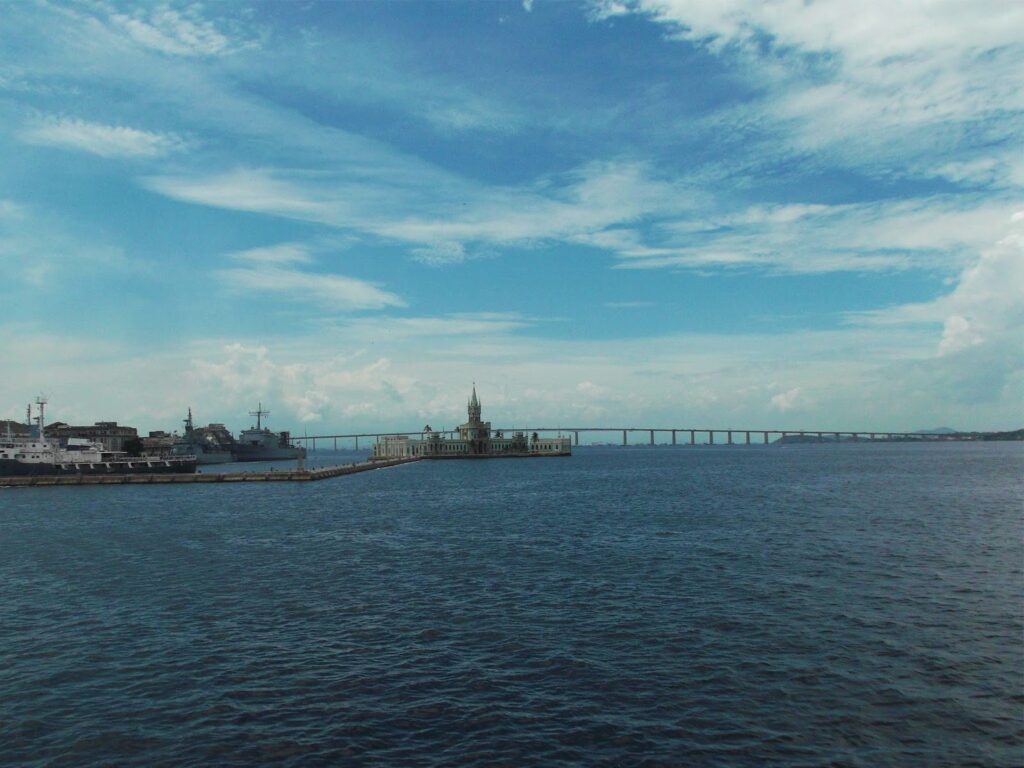
There are two ways how to get to Niterói. You can either go by bus crossing the Ponte Rio – Niterói. I find this completely pointless and not very charming.
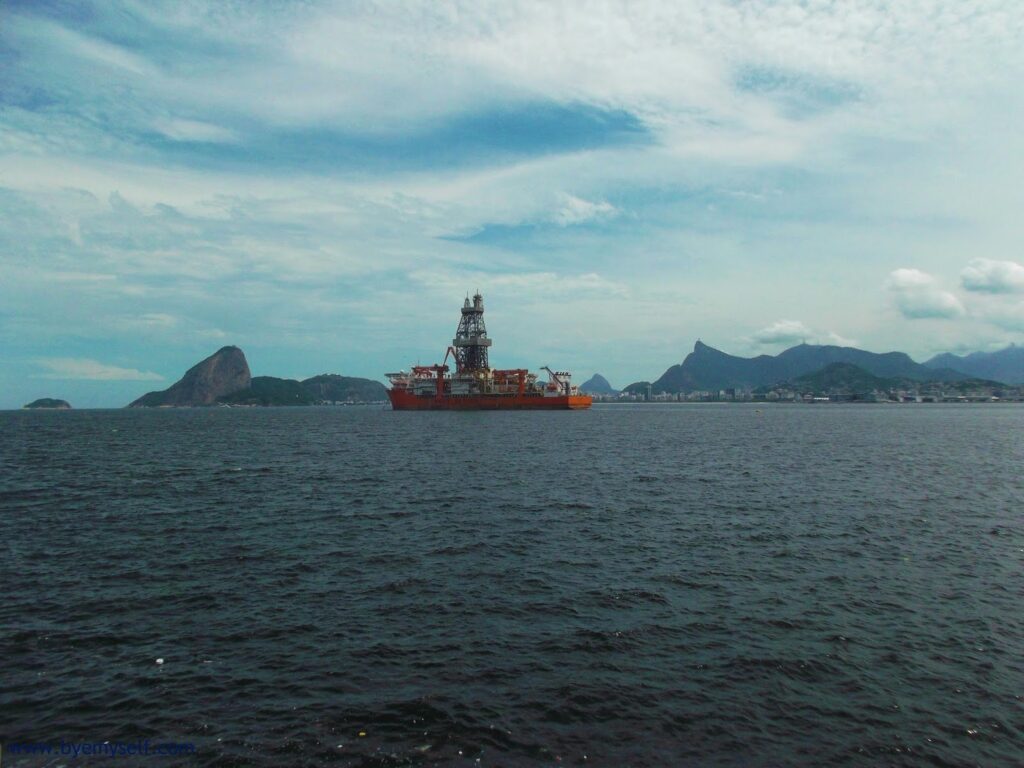
You absolutely should take the ferry that leaves Rio at the Estação das Barcas at Praça Quinze de Novembro behind the State Assembly.
This ferry operates daily from 6h às 23h30 and costs 6 R$ one way. It takes you to the Praça Arariboia in Niterói in about 20 minutes.
As you leave the terminal, you will spot a little mobile tourist information. Here you can obtain a map for free. Albeit, you don’t really need it. Just turn right and walk along the road as it’s turning along the shore. It’s a scenic walk of about 3 kilometers.
Museu de Arte Contemporânea de Niterói
I will not lie to you: When I visited the museum, there were two completely pointless exhibitions and I’ve heard from others that the venue cannot exactly pride itself on showing breathtaking art. The visit is still worth it – for the building and for the views.
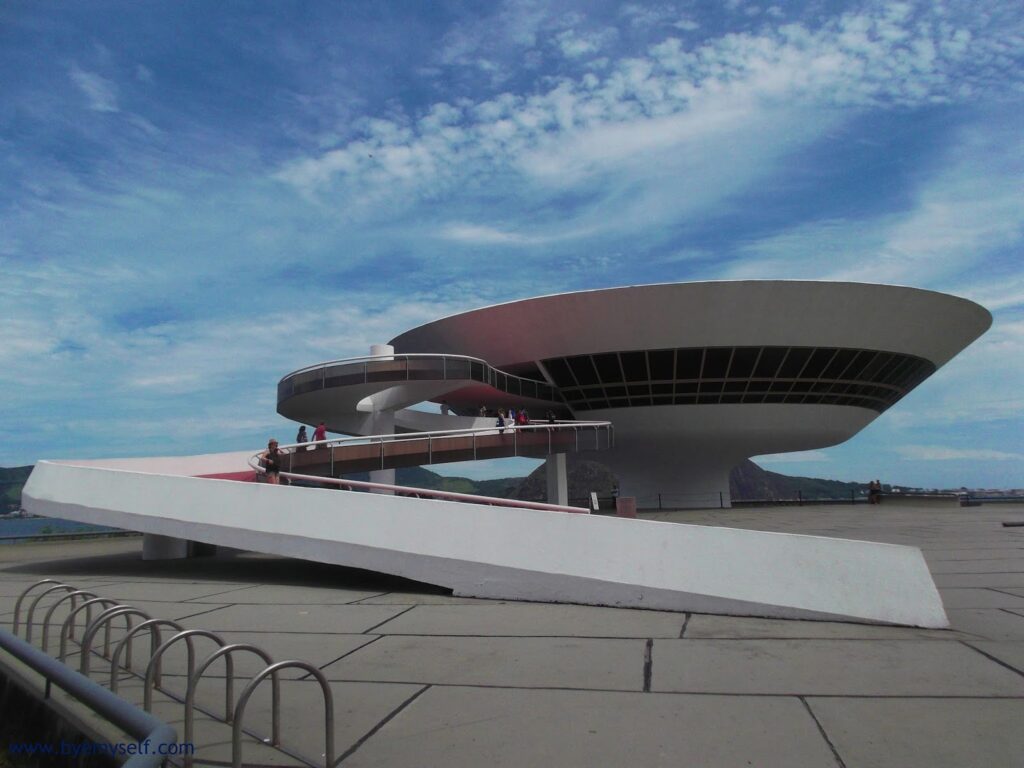
And another thing: You don’t have to walk there, there is a bus circling between the port and the Mirante, the observation point the museum was built on. Actually, I’d recommend walking there – which will take about 30 minutes – and taking the bus on your way back.
I will not lie to you. When I visited the museum, there were two completely pointless exhibitions. Actually, I’ve heard from others that the venue cannot exactly pride itself on showing breathtaking art. The visit is still worth it – for the building and for the views.
And another thing: You don’t have to walk there. As a matter of fact, there is a bus circling between the port and the Mirante, the observation point the museum was built on. Actually, I’d recommend walking there – which will take about 30 minutes – and then taking the bus on your way back.
Museu de Arte Contemporânea de Niterói (MAC)
Mirante da Boa Viagem
Niterói
Phone: + 55 – 21 – 26 20 24 81
Email: mac@macniteroi.com.br
The museum is open from Tuesday to Sunday from 10 a. m. to 6 p. m. and entrance fee are R$ 10,00
Practical Information
How to Get There…
By Plane
Antonio Carlos Jobim International Airport
If you are just coming to Brazil, you’ll probably arrive at the Antonio Carlos Jobim International Airport in Galeão on the outskirts of Rio de Janeiro. As a newbie, you’ll probably spend far too much for a cab at a licensed taxi stand – they charge around 120 R$ to the city center. Nevertheless, especially if you’ve just landed after dark, you still might want to take a cab. There are desks where you pay a standardized fare so that you don’t have to haggle with the driver.
However, a metered cab will cost about half of that.

Also, there is a comfy shuttle bus for R$ 15 going to Ipanema, making some additional stops on the way.
However, this can be tricky if you’re not familiar with Rio since the drivers are not helpful at all. If you know where you are going and you tell them, they stop. If you don’t know it, they just go.
Anyway, I wouldn’t recommend taking the bus after a long, tiring flight. In Rio, you have to be on the alert, and you won’t be when you are exhausted from travelling. Hey, you’ve paid a lot of money for a ticket, just spend some more and get to your final destination safely.
As I extensively pointed out in my post on travel anxiety and travel safety, the general rule should always be Safety First. It’s ridiculous to spend hundreds of dollars on an air ticket and eventually risk your life because of 30 bucks.
Airport RJ Santos Dumont
If you are coming from a different place in Brazil or another Latin American country, chances are that you’ll arrive at Santos Dumont airport. This one is basically in the city center. Consequently, the connection is no problem at all.
If in doubt, get on the light rail – the tram – to Cinelândia. There you have a connection to the subway system which is really good, reliable, and clean in Rio. And taking a cab won’t burn a hole in your pocket, either.
By Long Distance Bus
If you are coming by bus, you’ll arrive at the Terminal Rodoviário Novo Rio. While the bus terminal is pretty good with many services, the surroundings aren’t. Therefore, refrain from lingering around, especially after dark.
If you don’t want to take a cab, you can take the light rail at Rodoviário towards Santos Dumont. Then, you get off at Cinelândia and continue on the subway from there.
For more tips and hacks on how to save money and still travel comfortably, check out my posts on planning and organizing your trip respectively when to book ahead.
…and Around
Talking ’bout cabs: It’s very easy to move around in Rio. The public transport system covers the entire city – whether by Metrô, the subway, by light rail – or tram – or by bus. A ride costs about one dollar.
For each of these means, you can get a separate card that can be charged. But the only thing you save this way is time, no money. There is no such thing as a day ticket or some other form of a pass. You have to pay for every ticket individually. Also, tickets from one means of transport to another are not transferable. Hence, I wouldn’t really call it an elaborate system, but it takes you where you want to go easily and relatively fast.
Besides regular cabs, Uber is really big in Brazil, too.
Where to Stay
Obviously, in a touristy place like Rio de Janeiro, you’ll find everything from a bunk bed in a dorm of a cheap hostel to a wide range of luxury places.
The highest density of lodging options is along the Copacabana.
I personally loved to stay in Botafogo since it’s very comfortable and safe yet a truly Brazilian neighborhood. The adjacent quarter Flamengo is equally nice and recommendable.
On this map, you can check out lodging options* in the various neighborhoods of Rio de Janeiro:
Booking.comCash And Cards
The currency in Brazil is the Real (plural Reais) and the rate is 1 US$ = 4,86 R$ (April 2022). For further conversion check this page.
Apart from cash, you can pay by credit card at all the attractions I’m mentioning in this post.
Of course, there is cash and there are cards. Because of the relatively high crime rate such as pickpocketing, Brazilians tend to pay even tiny amounts with debit cards. Even street vendors and hawkers are accepting them when someone just buys a newspaper and chewing gum.
Although there are notably many ATMs all over the place, not all of them work with international credit cards. But don’t panic, there are so many different banks – sooner or later, you’ll figure out which one works with your card.
Especially in Rio de Janeiro, but also in other big cities like São Paulo or Belo Horizonte, be cautious where you use the ATM – you shouldn’t do your banking in whatever neighborhood and especially not after dark.
Language
Since Brazil used to be a Portuguese colony, people speak Portuguese. Surprisingly few people speak decent English.
Also, don’t rely on your knowledge of Spanish or Italian. Although I personally find that one could easily scrape through with these languages, most local people don’t seem to hear any similarity whatsoever.
I therefore strongly recommend learning at least some Portuguese before visiting, e. g. online with babbel.com.
For two weeks, I actually took language lessons which was a great experience and enriched my stay in many ways. To learn more about this option, please go to my post Language Learning in Brazil.
What to See
I’m an avid solo-travelling woman. Since solo-travel doesn’t equal solitude, I love to join organized tours here and there. They allow me to meet fellow travellers – for just a short moment or a lifelong friendship.
Therefore, here are some great ideas of what to do during your stay in Rio de Janeiro. Especially if you travel solo, they’ll enable you to see many great sites in a comfortable and most of all safe way*:
Connection and Communication
Brazil is one of the very few countries where I got a national SIM card. To be honest for the sole reason that I had accidentally blocked mine and wasn’t able to use my phone at all. I got a pre-paid card from Claro and was very happy with their service.
This being said, I prefer to use free WiFi. Actually, there was a connection to the internet without any issue at basically every museum, eatery or café, and, of course, hotel. Worked like a charm.
At the end of my trip to Brazil, I had three or four different adapters. Although there is an official type N socket and plug, you’ll find also type C plugs. Also, there were type A sockets like in the US – howsoever, it was a wild mix, but in the end, everything turned out fine.
Also, the voltage is either 127 or 220 V, and the frequency 60 Hz. Thank God, nowadays, all these chargers for phones and readers, and computers have integrated adapters. Therefore, voltage and frequency don’t really matter.
By the way, you’ll find this kind of practical travel info in my post World’s Most Complete Travel Information – an indispensable globetrotter-classic.
Map
Rio de Janeiro was only the first stop of my exciting visit to Brazil’s South. Go to the main post to check out all the other destinations. There you’ll also find valuable general information that will make your trip smoother.
Pinnable Pictures
If you choose to pin this post for later, please use one of these pictures:

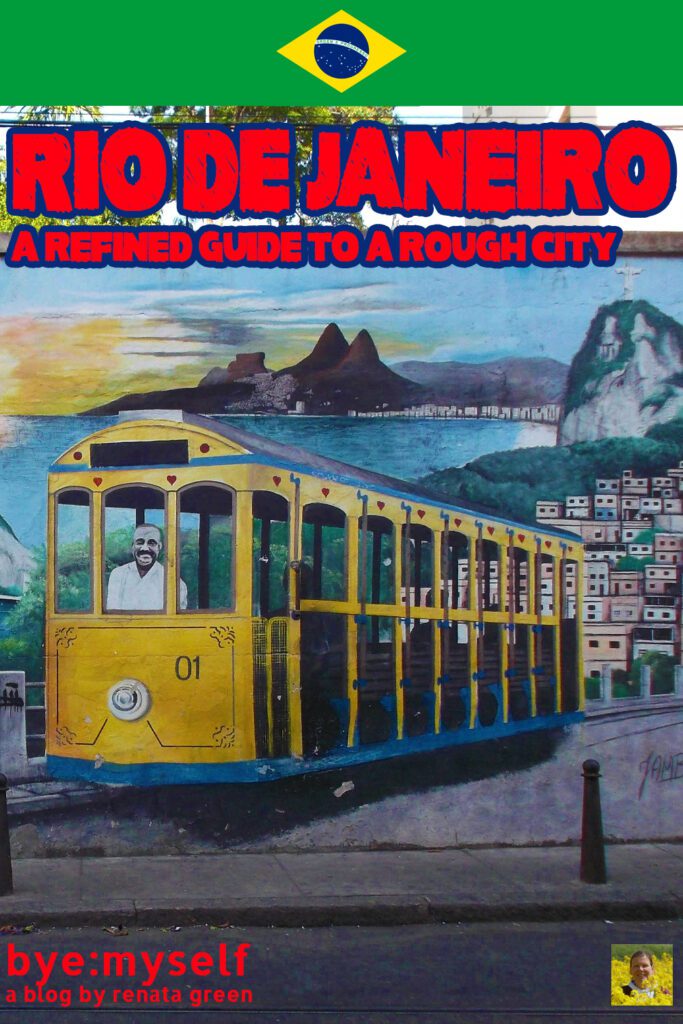
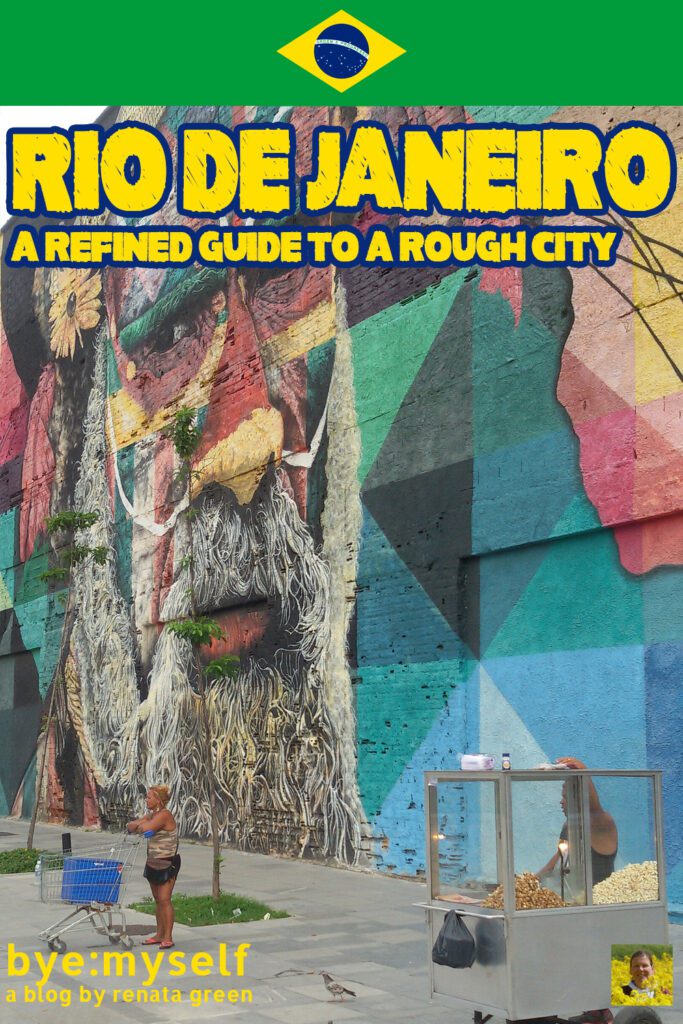
Note: This post is being regularly completed, edited, and updated – last in July 2023.
Did You Enjoy This Post? Then You Might Like Also These:
Guide to BONITO – where nomen est omen, definitely
Carnival in Rio de Janeiro – I am what I am…
Guide to BRAZIL – Travelling the South
Language Learning in Brazil
Street Art in Rio de Janeiro: The Voice of Colors by Rita, Eduardo, and Jorge
Guide to FOZ DO IGUAÇU – Where the Water Falls in Waterfalls
RIO DE JANEIRO – a refined guide to a rough city
Guide to CURITIBA – and a Day Trip to MORRETES
* This is an affiliate link. If you book through this page, not only do you get the best deal. I also get a small commission that helps me run this blog. Thank you so much for supporting me!
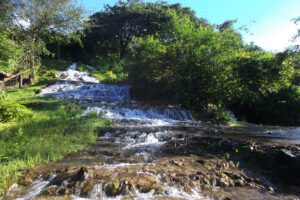

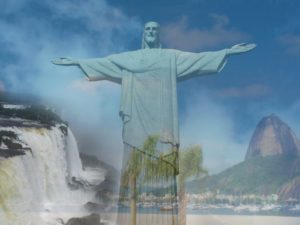

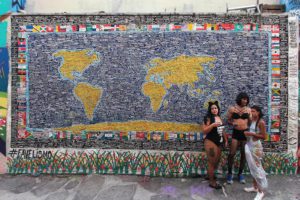
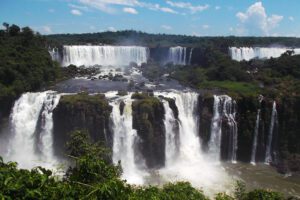

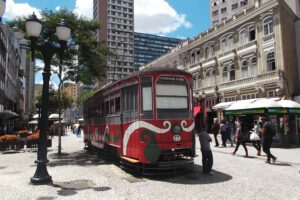
It is one of the places for the Carnival! It is a beautiful city, that my co-worker says (I work with a Brazillian).
Rio looks like a beautiful place to visit! It is totally a bucket list trip for me!
Would love to visit Brazil one day and check all the places. I have a good list to visit in Brazil
Two of the items on my bucket list are: Visit Copacabana and see Christ the Redeemer (one of the seven wonders). Now I have a legit reason to stay longer. I’m crazy about art especially architecture, and also history. Everything I see here is truly inviting. I also like that this post is complete, everything I need to know is in one place.
Thanks for this honest sharing about Rio, it makes me more prepared for my trip. Cheers Siennylovesdrawing
I love that you included information about the rough parts of Rio De Janeiro. Most travelers won’t do that. They want to show the perfect side in fear or discouraging people to go. Your post makes me better informed about where I go and what I do. It definitely does not discourage me from ever going to Rio.
This guide is really good introduction to Rio.
I have never visited Rio but seen lot of travel documentary’s and videos on it.
the main sights in the area. You have given lot of details which will be helpful for many who are planning to go there
I do hope to visit it one day! it looks so distant yet so beautiful!
My husband is from Sao Paolo, Brazil but I haven’t been there. We are planning to move there for good and I am hoping to visit the beautiful Rio De Janeiro.
Thank you! Your writing is open my mind about Rio. I was thinking to visit Rio, but now I’ll think twice, but I still want to be there.
Well, it’s a fascinating place, however, you need to be really careful.
This post is great. A lot of images and interesting places. Great read!
I only heard this RIO but it seems like a great place to visit! I’m looking to this place!
What a great, honest write up on Rio – it is always nice to hear the good and the bad so you can prepare.
I don’t even know how I ended up here, but I thought this post
was great.
I do not know who you are but definitely you are going
to a famous blogger if you aren’t already
Cheers!
I actually put a lot of work into my blog – I’m very glad it shows 😉
Wow Rio does look enticing but this was so informative, I had no idea just how diverse the neighbourhoods and beaches would be. It’s good to have all this information.
This is a really comprehensive guide as always. I have never visited Brazil but definitely hope to get there one day & I think this guide is invaluable. You make a very good point about taking a trip to see the favelas & it certainly doesn’t sound like something I will be adding to my itinerary when I do eventually make it there. Thank you for all the info.
I appreciate the honesty and transparency in this post. Although I can tell Rio is an amazing city, you also kept it real and mentioned the safety and dangerous aspects. I am wondering, have you been to Cape Town? Would you compare the situation to Cape Town? I have never been to Brazil and just want a frame of reference to know what Id be getting into in case I visit alone. Thanks for posting!
No, unfortunately, I haven’t been to South Africa yet – exactly due to the safety aspect. As a female solo traveller, I’m a bit hesitant when it comes to certain countries, and South Africa is one of them. That’s very sad since I’d love to visit the country 😉
We had two days in Rio when we visited South America. It was grey and rainy so we really did not do much and did not get the amazing views this city is noted for. West some interesting street art but would love to explore the different neighborhoods for more. And we certainly would go back for the beaches in the city and in nearby spots. You have certainly shown how much we missed! Some great tips to keep for planning a return visit.
Actually, I was surprised how often the sky was grey and it was raining – thought it would be much sunnier.
Loved Rio too! Would love to go back one day. Your article brings back memories. Regards, Elisa
Thanks for the comprehensive and honest guide to a very contrasting city. I love the photos you shared at Cristo Redentor, because isn’t it the weird reality of popular travel destinations these days. I love how you break down each neighborhood with highlights, pinned for future travel inspiration!
Haha, I have similar pix from the beaches in Thailand – actually two kinds: Those where I cleverly photographed around the tourist masses….and the cruel reality 😀
A great guide and pictures of Rio de Janeiro. I would love to see both this city and Brazil. I like that you give the prices of tourist attractions and opening hours. This is very helpful when planning a trip. On my bucket list in this city are: Copacabana, Museu de Arte Moderna, Ipanema, Pão de Açûcar, and of course Cristo Redentor and Trem do Corcovado.
You should add the Museu de Amanha – it’s absolutely fantastic. I measured my CO2 footprint…and was shocked. Well, it will have decreased last year since I hardly wasn’t able to fly…. 😉
This is a very informative guide to Rio. I have never visited yet, but knew a little bit about the main sights in the area. You have provided a lot of insight into other parts of Rio that I was not familiar with. This guide will definitely be helpful for planning a trip to Rio. Jardim Botânico looks beautiful! I would love to spend an afternoon exploring there. I would also love to check out the artwork at the various locations around Rio.
Yes, with Rio’s landmarks it’s a bit like the Eiffeltower 😉 you don’t have to visit for knowing them. This bein said…you still should 😉
Yes, with Rio’s landmarks it’s a bit like the Eiffeltower 😉 you don’t have to visit for knowing them. This being said…you still should 😉
I just bookmarked this for when I one day (hopefully soon) am able to visit. It’s been on my bucket list. Thank you for all this information about what to do and where to stay. ?
WOW, you provided such great insight! i now feel more informed and comfortable about traveling to brazil, thanks <3
This is such a useful guide! Very thorough! As someone who has never been to that part of the world, this guide really provides lots of useful information and I feel like I know a lot more about Brazil and Rio than I did before.
I feel like I would have to live in Rio for a year to be able to do most of the things listed in this guide! But if I had to prioritize I would start at the beaches of Ipenema & Copacabana. Don’t get me wrong, seeing Christ the Redeemer is a must for anyone visiting Rio but my vision is mainly beach life like Miami or Phuket for some reason!
Now I love street art and you found tons of it. I keep seeing the stairs in Santa Teresa so that would be a must see for sure! By the way, I actually laughed out loud at your comment about the Saint Sebastian Cathedral in Lapa! What a monstrosity!!! Did you go inside of it? Was there anything that could lessen the suffering of St. Sebastian?
😉 so glad I did not only inform you but actually made you laugh 😉
This is a wonderful guide! I didn’t know Rio de Janeiro was full of poverty and hopelessness. Thanks for sharing!!
The Lagoa Rodrigo de Freitas is beautiful – I would love strolling around this lagoon after a busy day in the city!
This guide is a great introduction to Rio! I honestly don’t know much about the city so I appreciate all of your insight.